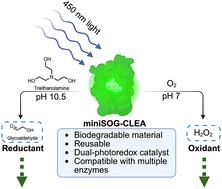MiniSOG as a biodegradable heterogeneous photocatalyst for coupled redox biotransformations
IF 4.7
Q2 MATERIALS SCIENCE, MULTIDISCIPLINARY
引用次数: 0
Abstract
Visible-light photocatalysis has emerged as a powerful strategy to drive chemical reactions under mild conditions, often in tandem with biocatalysts to achieve one-pot cascades. In this work, we demonstrate that the photocatalytic flavoprotein miniSOG, originally engineered as a genetically encoded singlet oxygen generator, can be repurposed as a heterogeneous photocatalyst. By immobilizing miniSOG as cross-linked enzyme aggregates (CLEAs), we enable controlled in situ production of hydrogen peroxide (H2O2) and NADH regeneration, facilitating both oxidative and reductive biotransformations.

MiniSOG作为一种可生物降解的非均相光催化剂用于偶联氧化还原生物转化
可见光催化已经成为一种在温和条件下驱动化学反应的强大策略,通常与生物催化剂串联以实现一锅级联。在这项工作中,我们证明了光催化黄蛋白miniSOG,最初被设计为基因编码的单线态氧气发生器,可以被重新利用为异相光催化剂。通过将miniSOG固定为交联酶聚集体(CLEAs),我们可以控制过氧化氢(H2O2)和NADH再生的原位生产,促进氧化和还原性生物转化。
本文章由计算机程序翻译,如有差异,请以英文原文为准。
求助全文
约1分钟内获得全文
求助全文
来源期刊

Materials Advances
MATERIALS SCIENCE, MULTIDISCIPLINARY-
CiteScore
7.60
自引率
2.00%
发文量
665
审稿时长
5 weeks
 求助内容:
求助内容: 应助结果提醒方式:
应助结果提醒方式:


